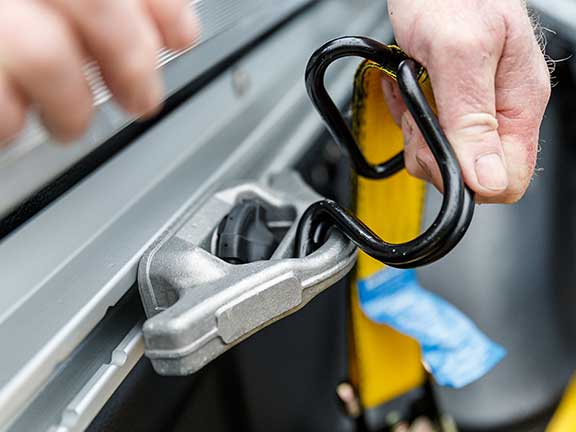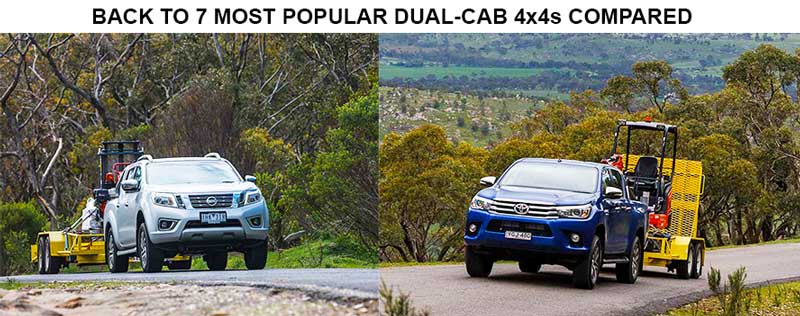All Nissan Navara NP300 dual-cab pick-ups, bar one base-spec variant, have coil rather than leaf springs at the rear.
Another new arrival for 2015, the Nissan Navara NP300 – also known as the D23 – has replaced both the (two generation old) D22 and the last generation D40 in Nissan’s ute line-up. Interestingly, the NP300 will also provide the basis for upcoming utes from Renault and Mercedes-Benz.
 |
|
Nissan’s adjustable tie-down system could do with some bigger eyelets!
|
The Nissan Navara stands out here for a number of reasons. Firstly, all bar one NP300 dual-cab pick-ups come with coil springs at the rear, and the NP300 is the only ute here to have two turbos rather than one. The sophisticated bi-turbo arrangement features a smaller and a larger turbo arranged sequentially on a 2.3-litre engine of Renault origin.
You can get a Navara dual-cab 4×4 with leaf springs at the rear, but only in the base-spec RX cab-chassis, and only with a single-turbo version (120kW) of the 2.3.
The Navara has adjustable tie-downs, but the eyes need to be bigger to be truly useful. The Navara’s rear dropped by 100mm with the 800kg pallet in the back, a lot more than all the other utes here bar the Triton.
Like the Triton, the 800kg pallet also causes problems for the Navara’s legal payload when you take into account the extra weight of the driver, observer and towbar. The lighter ST is okay, but with the heavier ST-X, the observer is again technically obliged to walk!
Underway and up the winding hill, the Navara doesn’t feel great chassis-wise with the 800kg on board. It bottoms out frequently over the bumps, and the sway from the rear is far more an issue than with the leaf-sprung vehicle. All in all, it doesn’t feel happy.
Far better news with the engine, however, which dismisses the 800kg in the tray, readily getting on with the job in more than admirable fashion. It’s still a bit noisier under load than what you expect of a modern-design European diesel, but, then again, it was originally designed for commercial-vehicle application, which will hopefully bode well for longevity.
The Navara is also unusual in this company with a seven-speed automatic, which does most things well and is an asset to what the punchy engine has to offer. No auto downshifts, however, on the descent with the load on board, which means resorting to the selector’s tip-shift function given the engine braking from the small, low-compression diesel isn’t great.
TOW TEST
The coil sprung multi-link rear end of the Nissan was the subject of much speculation in the lead-up to the tow test. The NP300 was launched with an emphasis on towing prowess. Unfortunately, our worst fears were confirmed. The rear of the Navara plummeted with a 3,500kg load behind it.
The twin-turbo 2.3-litre engine is another donk that does a lot with what it’s got. Sequential turbocharging keeps the combustibles flowing in at a decent rate to make the most of the relatively small engine capacity. Again, it has to be held back to stop rpm running away on downhill runs, but with enough right foot it still has the grunt to have a go. The auto needs to be stirred to get the most out of the driveline, but the biggest area of concern is the chassis.
I don’t say this lightly, but this suspension should not be rated at 3,500kg towing. It’s dangerous. Under load, the NP300 bump steered like no other vehicle in this test. The nose points skywards and the rear end squirmed more than a politician during a travel expense audit. I wouldn’t want to head to the local Bunnings like this, let alone around Australia.
The Navara’s hitch had a ball downforce rating of 300kg less than the 10 per cent of load usually used as a yardstick for a towed load at 3.5 tonne. Luckily, using a forklift and pallet as a counterweight meant we could move it around to get downforce and weight distribution to its optimum level. It would be hard to find a more balanced load to put behind a vehicle than the one we used.
The single-cab and extra-cab N300 in the Navara range sit on leaf springs and are solid workhorses. There is one dual-cab variant that sits on leaf springs, but it is only available with the lower-output single-turbo engine.
The bulk of everyday dual-cab buyers are leaning towards the higher-spec variants of all these utes, and it stands to reason that punters wanting to tow are going to head towards the higher-output engine.
Given the loaded performance of the coil-sprung rear end, I’d suggest its tow rating should be downrated and leaf springs offered across the range as a heavy tow pack option. The coils are way too compromised for hard work under load. It’s also worth mentioning the NP300 doesn’t feature trailer sway control as a part of its stability program.
NISSAN NAVARA PRICE
Nissan Navara ST: $45,990
Nissan Navara ST-X: $51,990
*4×4 bi-turbo dual-cab pick-up manuals only.
NISSAN NAVARA SPECS
Engine
2.3-litre 4-cyl bi-turbo diesel
Max power/torque
140kW/450Nm
Gearbox
Seven-speed automatic
4×4 system
Dual-range part-time
Tare weight
1,865kg to 1,921kg
GVM
2,910kg
Payload
930kg to 986kg
Towing capacity
3,500kg
Towball download (max)
300kg
GCM
5,910kg
Fuel tank capacity
80 litres
ADR fuel claim
7.0 litres/100km
*4×4 bi-turbo dual-cab pick-up automatics only.
Photography: Ellen Dewar and Nathan Jacobs





